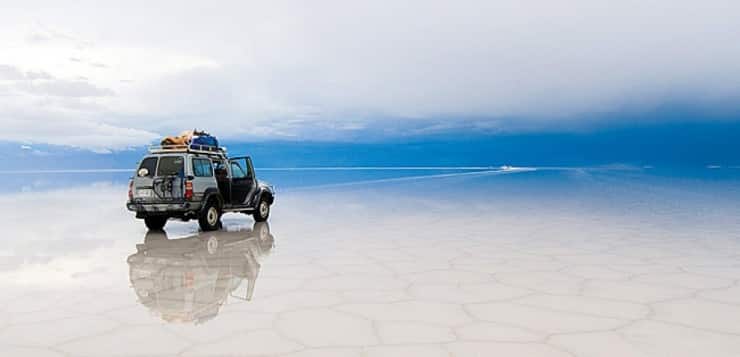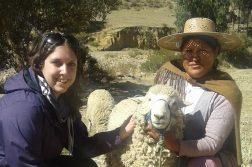Bolivia has long been known among travellers as the “Tibet of the Andes”, a phrase that brings to mind snow-capped peaks and barren high plains. Because of this image, many people are surprised to learn that 2/3 of Bolivia is tropical lowlands and jungle. Often considered the poorest and least developed country in South America, Bolivia is in fact full of wealth and culture.
This country of some nine million people has been my home since 1994, and today I still find myself breathless with its beauty and diversity. Perhaps even more amazing than the spectacular landscapes are the Bolivian people. Bolivia is known as the country with the most indigenous people in Latin America, and in 2005 it elected an indígena, Evo Morales, to be its president.
The Quechua and Aymara peoples are the best-known of the more than 30 Native cultures here. Traditional Quechua and Aymara practices such as ayni (reciprocal community work), ayllu (community with communal ownership of property) and reciprocity, as well as numerous rituals, are woven into the fabric of daily life. And a visit to the countryside where one sees the daily use of ritual in clearing a field or chewing coca affirms that the Pachamama (Mother Nature) is alive and well in the hearts of the Bolivian people.
Urban Bolivianos practice their traditions with a modern twist. On the first Friday of every month, dozens of small business people in downtown Cochabamba bless their store fronts and offices by burning an offering (q’owa) to Pachamama. Even the Catholic Church, which colonized Bolivia alongside the Spaniards, has fused indigenous traditions into their Sunday mass, and it is not uncommon to see priests blessing crops and animals with traditional offerings.
History
From the Incan guerrilla warrior Tupac Katari to the Water and Gas Wars of 2000, Bolivian history is rich with rebellion. The country was unified in 1825, but since that time it has not flourished with the promised democracy; rather, it has endured a series of dictatorships who, in alliance with powerful foreign business interests, have exploited the country’s mineral resources. Today almost any Bolivian over 40 harbours a personal story of exile, imprisonment, or state violence from those times.
In 2005, after several decades of sustained community organizing and protest, the people of Bolivia elected their first indígena president, Evo Morales. Under his administration a different era has begun. Changes include: a new constitution that reflects the needs of Native peoples and cultures; renegotiation of profits with formerly corporate-owned industries; attempts at land reform; and a country-wide literacy project.
The bottom line of Bolivia’s dramatic history is the strength of the people and their dedication to their cultures – and these qualities make this place not only the most indígena nation in Latin America, but also a leader in forging a post-colonial world.
Bolivia Welcomes You
From the heights (over 6,000 metres) of the Cordillera Real to the steaming jungles of the Amazon basin; from La Paz, a city of over a million people, with its Hyuano Potosí (6,088 metres); to the world-renowned Lake Titicaca whose deep blue waters offset the dry grasses of the wind-swept altiplano – Bolivia welcomes you.
You can visit Sucre, a bucolic colonial city that houses Bolivia’s national museums, and then travel to Potosí, once the largest urban area in South America, now a testament to the destruction that colonization wrought in its voracious appetite for silver.
The country has three major cities: La Paz, Santa Cruz, and Cochabamba. La Paz (at 3500 metres alt.) is a bustling cosmopolitan city situated in a bowl and surrounded by some of the most spectacular mountains in the world. The streets are full of life, every neighbourhood has a vibrant local market, and the pre-Incan ruins of Tiawanaku are a day-trip away. In June you will enjoy the cultural and social event of the year: the Gran Poder festival with its non-stop dancing.
To the east, tropical Santa Cruz is known as the economic center with its agro-industrial businesses. Rapid growth has given the city a hodgepodge look, making it a less charming place for most travellers – but it is the jumping-off spot for sights well worth visiting. One of these is Parque Nacional Amboro, probably the most accessible of the national parks and the site of beautiful cloud forests. East of Santa Cruz, the flat plains are home to the Chiquitano people and dotted with the exquisitely reconstructed Jesuit mission churches.
Last but not least is the less-visited city of Cochabamba. Situated in a fertile valley surrounded by small family farms, it produces an almost endless variety of vegetables and fruit. This fact translates into an extensive local cuisine and the local saying: “We live to eat, not eat to live.” The city is a perfect place for studying Spanish or Quechua – or just relaxing and getting to know the people. A number of local groups offer volunteer-work opportunities, and many a traveller has stayed “un ratito mas,” as Cochabamba is truly is a hard place to leave.
Heads Up!
Two destinations should not be missed.
The first is Lake Titicaca. Located 75 km from La Paz, this immense lake is the largest high-altitude body of water in the world. Its vastness is a breath-taking sapphire blue, and the shoreline is dotted with the same reed boats, llamas, and farmers tilling the land as they have done for centuries. Copacabana is the best-known town on the lake, offering a comfortable base from which to explore. And do not miss the cathedral and its black Virgen de Candelaria, nor neglect to feast on a plate of fresh lake trout before catching a boat to spend a few days exploring the stunning Isla del Sol just a short boat ride away.
The second must-see spot is the Salar de Uyuni, an indescribable expanse of salt flats that attracts visitors from all over the world. At over 12,000 square kilometres, this lake is the world’s largest, its white expanses displaying such treasures as the Red and Green Lakes, thousands of pink flamingos, and some of the strangest rock formations you will ever see. Reliable guides abound, and any travel agency can organize a tour.
So whether you are looking to enjoy the energetic, bustling cosmopolitan cities or the wide expanses of wild nature, Bolivia welcomes you!!!
Contributed by: Lee Cridland
Co-director of Volunteer Bolivia www.volunteerbolivia.org and Bolivia Cultura both based in Cochabamba, Bolivia, offering unique travel and volunteer opportunities.





